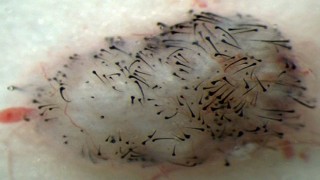

Sanford-Burnham Medical Research Institute
Scientists at Sanford-Burnham used stem cells to grow new hair.
In a new study from Sanford-Burnham Medical Research Institute (Sanford-Burnham), researchers have used human pluripotent stem cells to generate new hair. The study represents the first step toward the development of a cell-based treatment for people with hair loss. In the United States alone, more than 40 million men and 21 million women are affected by hair loss. The research was published online in PLOS One yesterday.
“We have developed a method using human pluripotent stem cells to create new cells capable of initiating human hair growth. The method is a marked improvement over current methods that rely on transplanting existing hair follicles from one part of the head to another,” said Alexey Terskikh, Ph.D., associate professor in the Development, Aging, and Regeneration Program at Sanford-Burnham. “Our stem cell method provides an unlimited source of cells from the patient for transplantation and isn’t limited by the availability of existing hair follicles.”
The research team developed a protocol that coaxed human pluripotent stem cells to become dermal papilla cells. They are a unique population of cells that regulate hair-follicle formation and growth cycle. Human dermal papilla cells on their own are not suitable for hair transplants because they cannot be obtained in necessary amounts and rapidly lose their ability to induce hair-follicle formation in culture.
“In adults, dermal papilla cells cannot be readily amplified outside of the body and they quickly lose their hair-inducing properties,” said Terskikh. “We developed a protocol to drive human pluripotent stem cells to differentiate into dermal papilla cells and confirmed their ability to induce hair growth when transplanted into mice.”
“Our next step is to transplant human dermal papilla cells derived from human pluripotent stem cells back into human subjects,” said Terskikh. “We are currently seeking partnerships to implement this final step.”
The study was performed in collaboration with the Laboratory of Cell Proliferation at the Koltsov Institute of Developmental Biology in Moscow, Russia
This study was supported by funds from Sanford-Burnham.
ABOUT SANFORD-BURNHAM MEDICAL RESEARCH INSTITUTE
Sanford-Burnham Medical Research Institute is dedicated to discovering the fundamental molecular causes of disease and devising the innovative therapies of tomorrow. Sanford-Burnham takes a collaborative approach to medical research with major programs in cancer, neurodegeneration and stem cells, diabetes, and infectious, inflammatory, and childhood diseases. The Institute is recognized for its National Cancer Institute-designated Cancer Center, its NIH-designated Neuroscience Center Cores, and expertise in drug discovery technologies. Sanford-Burnham is a nonprofit, independent institute that employs more than 1,000 scientists and staff in San Diego (La Jolla), Calif., and Orlando (Lake Nona), Fla. For more information, visit us at sanfordburnham.org.
Sanford-Burnham can also be found on Facebook at facebook.com/sanfordburnham and on Twitter @sanfordburnham.
Contact Information
Patrick Bartosch
Manager, Communications
pbartosch@sanfordburnham.org
Phone: 407-745-2097












